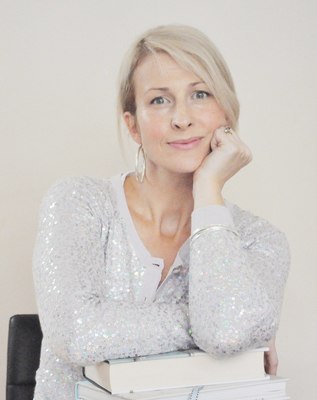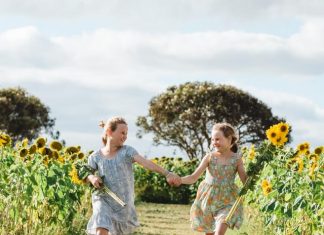By TANIA MCCARTNEY
Labels. They’re everywhere – literally and figuratively. Not just brandishing the necklines of designer ware, stamped into laptop lids and pockmarking every apple in the barrel at your local supermarket, they’re also licked and stuck to the intangible. They’re even stuck to our kids.
Shy, outgoing, gifted, naughty. Smart, dreamy, talented, lazy. Happy, sad, angry, excited. Labels, labels, everywhere, and children openly seizing and living up to them. O, beware the label, for it not only secures the fate of the labelled one, it erases the complexity and unique combination of elements that make up each and every one of our children.
Sure, labels are oftentimes helpful. They can help us delineate, learn and understand life in a broader context. And for early childhood, they’re a valuable part of the educational construct. Sometimes they are elegant in their simplicity, as is the way with concept books – early childhood creations that teach kids the basics of spatial – and self-awareness. Up and down, left and right, right and wrong, black and white.
But as we know, life is never black and white. The shades of grey are innumerable. And if addressing life subtleties can help very young children become more self-aware, more open and compassionate human beings, then I’m all for grey. And silver, smoke, slate, stone, ash, dove and flannel, for that matter.
As children grow, they begin to grasp complexity and inconsistency. Things certainly become less black and white, but I don’t think we can underestimate the ability of very little kids to explore and understand the complexities of the ‘spaces between’. This is especially true for children who struggle with learning, socialising and expressing how they feel.
Let’s take Happy and Sad as an example. These supposedly opposing emotions sit at the opposite ends of the spectrum. You’re either happy or you’re sad. Exclusively. But what about melancholy? Whimsical? Misty-eyed? Reminiscent? What about cheerful, glad, merry, perky, tickled-pink? What about those oddball feelings that don’t even really have a label – like when a balloon pops? Is the feeling shock? Or is it surprise, anger, elation, disappointment, devastation? A blending or some or all of these things?
Young children live freely and effulgently. They don’t yet have the self-awareness and social markers that temper their emotional response. And while this is often a charming thing, it can also become a struggle for kids whose lack of emotional understanding and control can develop into fear-responses like anxiety, depression or phobia … all of which have devastating effects on little bodies and minds.
Labelling emotions (and so many other things) at either end of the spectrum means kids miss the countless levels of nuance that live within each and every one of us. Those subtle changes and shifts in our internal world are key to both self-understanding and full expression.
As a long-time ambassador for juvenile literacy and an author/illustrator for little ones, I believe in creating books that not only celebrate our differences, but the subtleties that make us who we are. Didactic books, heavy with morals, scratch against my very skin. Children are far more intuitive and receptive to subtlety than we realise and it’s long been said that patronising books are a fast track to literary disengagement for kids.
We simply can’t underestimate the ability of even very young children to comprehend nuance in story books. Even if they can’t consciously express an understanding of this nuance, it’s definitely there, and that understanding is sourced more easily than with more flagrant narratives. This concept is what inspired, and what is explored in, my picture book Smile Cry.
I wanted to create a story for little ones that took two opposing emotions – happy and sad – and put them at opposite ends of the book so that both narratives met in the middle (as opposing emotions so often do). As the two stories travel to meet, subtle shifts in the concept of ‘happy’ and ‘sad’ occur. So instead of just feeling happy or just feeling sad, kids can learn about the blending of these two strong emotional states … how they can overlap and morph and become relatively inexplicable. Label-less, if you will.
In Smile Cry, children can explore a ‘balloon-pop cry’. A ‘need a bandage quick cry’ or an ‘ice-cream plopping down cry’. They can also explore a ‘tick smile’, a ‘silly smile’ or a ‘hug-a-cuddly-monkey smile’. And of course, each of these smiles and cries can differ in intensity, depending on the child in question. There is no one blanket term for any emotion – and this allows kids to develop a much deeper understanding of their own inner being.
Presenting emotions in this way not only taps directly into child-speak and burgeoning imaginations, it has a secondary effect. It teaches children that feeling happy can also be tinged with love and affection. Or excitement and confidence. It can teach them that feeling sad can quickly morph with indignation or shock. Helplessness or loss.
The concept of labelling is definitely learned behaviour. It’s not innately present in young children, who live without internal boundaries. Children inherently know the boundlessness of their being, and labels can sometimes kybosh this understanding.
Books and stories are a fine way to help little ones understand less tangible aspects of life, such as the way we feel … and to free themselves of labels and limited thinking. We are complex beings, and if we can foster this notion as our children grow – by harnessing subtlety and nuance – we will not only enhance our kids’ lives, we’ll set them free. Free of the dreaded label.
– Tania McCartney is an award-winning author, illustrator, editor, the founder of Kids’ Book Review and a long-time champion of juvenile literacy. She has been an ambassador for the National Year of Reading and is a current ambassador of the Chief Minister’s Reading Challenge. Her latest children’s picture book, Smile Cry (EK Books $19.99), illustrated by Jess Racklyeft, is at all good book stores. www.taniamccartney.com








